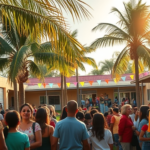Two Charged in Cameron County for Fatal Fentanyl Overdoses
The Rio Grande Valley community grapples with shock and concern as authorities charge two individuals with murder following a series of fatal fentanyl overdoses in Cameron County. The charges mark a significant development in the ongoing battle against the opioid crisis affecting South Texas, raising questions about the availability and management of such dangerous substances in local neighborhoods.
Understanding the Charges
The charges filed against the two suspects, unveiled by the Cameron County District Attorney’s office, signal a strong stance against the proliferation of fentanyl, a potent synthetic opioid that has been linked to numerous overdose deaths across the United States. According to the District Attorney, the defendants are believed to have knowingly distributed fentanyl-laced drugs, leading to the tragic fatalities.
“Fentanyl is a life-threatening substance, and those who choose to distribute it must understand the grave consequences of their actions,” said District Attorney Luis Perez. “These charges emphasize our commitment to seeking justice for the victims and their families, as well as safeguarding our community.”
The RGV’s Struggle with Opioids
The Rio Grande Valley, like many regions across the country, has faced increasing challenges from the opioid epidemic. While the Valley is renowned for its rich culture and tight-knit communities, it has not been immune to the devastating impacts of drug abuse.
Local law enforcement has documented a worrying uptick in fentanyl-related incidents over recent years. Valley residents are raising concerns about the presence of illegal substances in otherwise safe environments, and local leaders are looking to bolster preventive measures.
Dr. Laura Castillo, a public health expert at the University of Texas Rio Grande Valley, underscores the urgency of addressing this crisis. “Opioid addiction and fatal overdoses are a public health emergency, and we must adopt a comprehensive approach involving education, intervention, and law enforcement to combat it effectively,” she stated.
Impact on the Community
The implications of such criminal proceedings extend beyond legal repercussions, sparking dialogues within the community about substance abuse and safety. For South Texas, and particularly the tightly connected neighborhoods within the RGV, the incident serves as a sobering reminder of the threats posed by fentanyl.
Many Valley residents are expressing anxiety about the presence of potent drugs in schools and social gatherings. Maria Torres, a concerned parent from Harlingen, highlighted her worry, saying, “As a mother, it’s terrifying to think that our children might come into contact with something so dangerous. We need stronger protective measures to ensure their safety.”
Link to Previous Events
This case ties into broader efforts within the RGV to address drug-related offenses and improve public awareness. Previous initiatives, including community workshops and anti-drug campaigns, have sought to educate locals on the dangers of drug misuse.
Thomas Hernandez, director of a local drug rehabilitation center, emphasizes the importance of ongoing community involvement. “We’ve been working relentlessly to reach out to the youth and educate families about addiction’s risks. It’s vital that Valley residents collaborate to form a united front against such pervasive issues,” he asserted.
Looking Ahead: Implications and Solutions
Moving forward, the prosecution of these individuals could catalyze further efforts to curb fentanyl distribution and consumption in the region. The trial may set precedents for handling similar cases, reinforcing the legal system’s role in deterrence.
However, a holistic approach remains crucial. Investing in rehabilitation programs, mental health services, and supportive infrastructures can offer viable paths to recovery and prevention.
From a law enforcement perspective, Cameron County officials are intensifying efforts to break supply chains and prosecute offenders. Collaborations between local police, state agencies, and neighboring counties aim to dismantle networks responsible for introducing fentanyl into communities.
Balancing Perspectives and Community Actions
While the murder charges reflect a legal strategy to hold distributors accountable, some critics argue that punitive measures alone may not suffice. Advocates for reform emphasize treatment, compassion, and prevention as equally critical components of meaningful drug policy.
Andrew Lopez, a policy analyst, mentions the need for comprehensive solutions: “Balancing enforcement with accessibility to treatment is necessary for lasting change. By addressing root causes, we’re more likely to mitigate this crisis effectively.”
Resources and Community Support
In light of recent events, Valley residents are encouraged to engage with available resources for support and information. Several organizations within the RGV offer helplines, counseling sessions, and educational materials designed to assist those affected by opioid misuse.
For immediate assistance, residents can contact the South Texas Crisis Response hotline or visit local health departments for guidance on substance abuse programs. As the community navigates these challenges, unity and proactive engagement are essential for creating a safer environment for all.
In sum, the RGV’s confrontation with fentanyl underscores the complexity of drug abuse issues and the multifaceted response required to safeguard Valley residents. As the legal proceedings unfold, they reflect broader hopes for justice, prevention, and healing.







